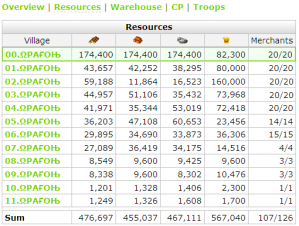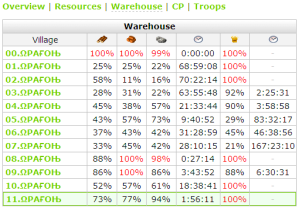Aside from the aggression of some players, the most challenging aspect of playing Travian is resource management. From my previous initial games, usually crops would be crucial.
When I tried my first game of the local version of Travian hosted at ph2, I found out within a week—never knowing any better—that I was depleting most crops produced for troop-making and creating buildings. It was not a surprise, suffice it to say, that there were times when the Capital was only producing and eventually consuming ALL crops except one—yes, a singular—unit of  crop.
crop.
After reading virtually most of the on-line Travian help, players’ posts in the Travian Forum, and a number of other web sites discussing Travian, I vowed never to repeat the same mistake, i.e., a singular unit of  crop, in subsequent local or international Travian games. For this server, I kept that promise, and probably overdone it! The most needed resource for my account in this server was
crop, in subsequent local or international Travian games. For this server, I kept that promise, and probably overdone it! The most needed resource for my account in this server was  clay! Here are the statistics:
clay! Here are the statistics:
 The snapshot shown right was taken a day after the server ended last 31 January. Hereunder are the respective levels of resource production at four [4] largest Villages:
The snapshot shown right was taken a day after the server ended last 31 January. Hereunder are the respective levels of resource production at four [4] largest Villages:
The Capital, 00, produced the following units per hour:
6784  lumber (with 25% oasis),
lumber (with 25% oasis),
6352  clay,
clay,
6764  iron, and
iron, and
3161  crop (with 25% oasis).
crop (with 25% oasis).
Realization only came after the game that I failed to upgrade the  clay fields to the same level as the other resources.
clay fields to the same level as the other resources.
The Village 01, a secondary village, a 3 -3
-3 -3
-3 -9
-9 village, produced
village, produced
1800  lumber (with 25% oasis),
lumber (with 25% oasis),
1800  clay (with 25% oasis),
clay (with 25% oasis),
1500  iron, and
iron, and
2405  crop (with 25% oasis).
crop (with 25% oasis).
Moreover, Village 02, a 1 -1
-1 -1
-1 -10
-10 village, produced
village, produced
600  lumber (with 25% oasis),
lumber (with 25% oasis),
500  clay,
clay,
600  iron (with 25% oasis), and
iron (with 25% oasis), and
1421  crop (with 25% oasis). Even after the attacks on this Village a few days before the server ended, the level-20 Granary was always full at 160,000-unit capacity! In the Philippine server, a friend once suggested never to settle a 1
crop (with 25% oasis). Even after the attacks on this Village a few days before the server ended, the level-20 Granary was always full at 160,000-unit capacity! In the Philippine server, a friend once suggested never to settle a 1 -1
-1 -1
-1 -10
-10 village unless necessary or at least make it as the realm’s Capital, which was my original plan for this server.
village unless necessary or at least make it as the realm’s Capital, which was my original plan for this server.
The Village 03, another 3 -3
-3 -3
-3 -9
-9 village, produced
village, produced
1800  lumber (with 25% oasis),
lumber (with 25% oasis),
1500  clay,
clay,
1500  iron, and
iron, and
2505  crop (with 50% oasis).
crop (with 50% oasis).
In retrospect, the location (see Expanded Map) for the succeeding Villages after the Capital, might have been a bad choice. I should have taken the  clay oasis nearest Village 04, instead of the
clay oasis nearest Village 04, instead of the  iron!
iron!
 The snapshot of Warehouse and Granary capacities, shown right, attests to the overflowing crops. More than half of all twelve Villages had their respective Granary full to the brim. Aside from
The snapshot of Warehouse and Granary capacities, shown right, attests to the overflowing crops. More than half of all twelve Villages had their respective Granary full to the brim. Aside from  crops, the Villages were also abundant in
crops, the Villages were also abundant in  iron augmented by three (3) conquered iron oases! Most of the excess iron and crops were traded for
iron augmented by three (3) conquered iron oases! Most of the excess iron and crops were traded for  clay.
clay.
Unfortunately, most Roman offensive troops, except Legionnaire, Equites Imperatoris and Battering Ram, require more clay compared to lumber; note that total iron production was more than enough to create these troops.
With any Travian game, defense is always crucial. Priority was given to the creation of a multitude of Praetorian (100  , 130
, 130  , 160
, 160  ) for the Villages of my realm as well as reinforcements to the Wonder of the World for the unacknowledged confederation with PK alliance; and a bevy of Equites Caesaris (550
) for the Villages of my realm as well as reinforcements to the Wonder of the World for the unacknowledged confederation with PK alliance; and a bevy of Equites Caesaris (550  , 640
, 640  , 800
, 800  ) mostly to serve as cavalry defense for my scattered Villages. Both these particular defensive troops were virtually clay-needy compared to wood/lumber.
) mostly to serve as cavalry defense for my scattered Villages. Both these particular defensive troops were virtually clay-needy compared to wood/lumber.
Lesson learned: Defense troops need  (crops) to eat, but
(crops) to eat, but  (clay) is equally essential to playing Romans! Next time, when playing Romans conquer more clay oases!
(clay) is equally essential to playing Romans! Next time, when playing Romans conquer more clay oases!
Notes:
To clarify, the first ever Travian game I played ended in tragedy. A post entitled: Internet Dogs, was dedicated to that experience.
 Disclaimer: These posts do not necessarily represent any organization’s positions, strategies or opinions; refer to this blog’s self-imposed rules: A New Year; New Rules. Unless otherwise expressly stated, posts are licensed under a Creative Commons Attribution-Noncommercial-No Derivative Works 3.0 License. Comments are moderated to keep the discussion/s relevant and civil. Readers are responsible for their own statement/s.
Disclaimer: These posts do not necessarily represent any organization’s positions, strategies or opinions; refer to this blog’s self-imposed rules: A New Year; New Rules. Unless otherwise expressly stated, posts are licensed under a Creative Commons Attribution-Noncommercial-No Derivative Works 3.0 License. Comments are moderated to keep the discussion/s relevant and civil. Readers are responsible for their own statement/s.
Travian comx2 Ends, Part V
Tags: Aggression, Alliance, Attack, Battering Ram, Building, Capacity, Cavalry, Challenge, Clay, comx2, Confederation, Crop, Defense, Equites Caesaris, Equites Imperatoris, Experience, Forum, Game, Gaming, Granary, Help, International, Internet Dogs, Iron, Legionnaire, Lumber, Management, Map, Mistake, Oasis, Offensive, On-line, ph2, Philippine, PK, Play, Player, Post, Praetorian, Qualifying, Reinforcement, Resource, s2, Snapshot, Tragedy, Travian, Troop, Warehouse, Wonder of the World, Wood
Aside from the aggression of some players, the most challenging aspect of playing Travian is resource management. From my previous initial games, usually crops would be crucial.
When I tried my first game of the local version of Travian hosted at ph2, I found out within a week—never knowing any better—that I was depleting most crops produced for troop-making and creating buildings. It was not a surprise, suffice it to say, that there were times when the Capital was only producing and eventually consuming ALL crops except one—yes, a singular—unit of crop.
crop.
After reading virtually most of the on-line Travian help, players’ posts in the Travian Forum, and a number of other web sites discussing Travian, I vowed never to repeat the same mistake, i.e., a singular unit of crop, in subsequent local or international Travian games. For this server, I kept that promise, and probably overdone it! The most needed resource for my account in this server was
crop, in subsequent local or international Travian games. For this server, I kept that promise, and probably overdone it! The most needed resource for my account in this server was  clay! Here are the statistics:
clay! Here are the statistics:
The Capital, 00, produced the following units per hour: lumber (with 25% oasis),
lumber (with 25% oasis), clay,
clay, iron, and
iron, and crop (with 25% oasis).
crop (with 25% oasis). clay fields to the same level as the other resources.
clay fields to the same level as the other resources.
6784
6352
6764
3161
Realization only came after the game that I failed to upgrade the
The Village 01, a secondary village, a 3 -3
-3 -3
-3 -9
-9 village, produced
village, produced lumber (with 25% oasis),
lumber (with 25% oasis), clay (with 25% oasis),
clay (with 25% oasis), iron, and
iron, and crop (with 25% oasis).
crop (with 25% oasis).
1800
1800
1500
2405
Moreover, Village 02, a 1 -1
-1 -1
-1 -10
-10 village, produced
village, produced lumber (with 25% oasis),
lumber (with 25% oasis), clay,
clay, iron (with 25% oasis), and
iron (with 25% oasis), and crop (with 25% oasis). Even after the attacks on this Village a few days before the server ended, the level-20 Granary was always full at 160,000-unit capacity! In the Philippine server, a friend once suggested never to settle a 1
crop (with 25% oasis). Even after the attacks on this Village a few days before the server ended, the level-20 Granary was always full at 160,000-unit capacity! In the Philippine server, a friend once suggested never to settle a 1 -1
-1 -1
-1 -10
-10 village unless necessary or at least make it as the realm’s Capital, which was my original plan for this server.
village unless necessary or at least make it as the realm’s Capital, which was my original plan for this server.
600
500
600
1421
The Village 03, another 3 -3
-3 -3
-3 -9
-9 village, produced
village, produced lumber (with 25% oasis),
lumber (with 25% oasis), clay,
clay, iron, and
iron, and crop (with 50% oasis).
crop (with 50% oasis).
1800
1500
1500
2505
In retrospect, the location (see Expanded Map) for the succeeding Villages after the Capital, might have been a bad choice. I should have taken the clay oasis nearest Village 04, instead of the
clay oasis nearest Village 04, instead of the  iron!
iron!
Unfortunately, most Roman offensive troops, except Legionnaire, Equites Imperatoris and Battering Ram, require more clay compared to lumber; note that total iron production was more than enough to create these troops.
With any Travian game, defense is always crucial. Priority was given to the creation of a multitude of Praetorian (100 , 130
, 130  , 160
, 160  ) for the Villages of my realm as well as reinforcements to the Wonder of the World for the unacknowledged confederation with PK alliance; and a bevy of Equites Caesaris (550
) for the Villages of my realm as well as reinforcements to the Wonder of the World for the unacknowledged confederation with PK alliance; and a bevy of Equites Caesaris (550  , 640
, 640  , 800
, 800  ) mostly to serve as cavalry defense for my scattered Villages. Both these particular defensive troops were virtually clay-needy compared to wood/lumber.
) mostly to serve as cavalry defense for my scattered Villages. Both these particular defensive troops were virtually clay-needy compared to wood/lumber.
Lesson learned: Defense troops need (crops) to eat, but
(crops) to eat, but  (clay) is equally essential to playing Romans! Next time, when playing Romans conquer more clay oases!
(clay) is equally essential to playing Romans! Next time, when playing Romans conquer more clay oases!
Notes:
To clarify, the first ever Travian game I played ended in tragedy. A post entitled: Internet Dogs, was dedicated to that experience.
Share this: